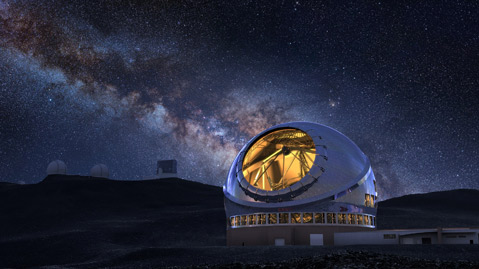Construction Halted on Yang’s Giant Telescope
Native Hawaiians Protest 18-Story Observatory on Sacred Ground

The future of one of the world’s largest telescopes — for which UCSB Chancellor Henry Yang chairs the board — proposed for the highest peak in Hawai‘i received an unfavorable ruling last week from the Hawai‘i Supreme Court. The order temporarily prohibiting workers from maintaining idled vehicles sitting atop Mauna Kea is relatively minute, but the state’s high court justices previously questioned the due process of the land-use permits issued for the $1.4 billion project — central to a fight between Thirty Meter Telescope (TMT) proponents and many Hawaiian natives.
The University of California partnered with Caltech 15 years ago to plan for the next generation’s premier land-based telescope — 13 times greater than the orbiting Hubble Space Telescope. The 18-story observatory, proponents say, would more sharply measure the first stars formed after the big bang and advance the possibility for humans to live on other planets. In 2003, the Gordon and Betty Moore Foundation gave an initial grant to design the state-of-the-art telescope and have since pledged a total of $250 million. Four other nations — Japan, China, India, and Canada — are also part of the effort. The University of Hawai‘i granted a sublease to TMT to build on the mountain.
But construction of the observatory has been stalled since early April, when hundreds of protesters blocked workers from traveling up the mountain, a place deemed sacred and ecologically sensitive to native Hawaiians. Thirty-one people were arrested, and protests erupted on Maui and other islands. Earlier this month, TMT said it planned to do site preparation work in the near future. Opponents promised to mobilize last week, but the court’s ruling placated protesters.
The crux of the debate is that the state’s Department of Land and Natural Resources (DLNR) granted a conditional permit in 2013 before a contested case hearing took place. TMT opponents challenged the permit, arguing the department put the cart before the horse. In August, attorneys representing the state contended the move was akin to a routine preliminary ruling.
But the five justices — including Richard Pollack, who is a UCSB grad — took great exception to that logic. “I was a trial judge,” Pollack said. “I don’t recall ever making a decision that decided the case before the trial.”
Last week, Yang said in an email that TMT would respectfully await the Supreme Court’s final decision while work is done all over the world to develop and build components for the observatory. “We are deeply committed to … the vision that integrates science and culture in Hawaii and enriches educational opportunities and the local economy,” he said.
TMT opponents, meanwhile, argue the issue has been wrongly construed as a debate between science and culture. “This has nothing to do with astronomy,” said Kealoha Pisciotta, who is the president of Mauna Kea Anaina Hou, which is appealing the permit. “If they were trying to build a hospital, it would be the same issue.”
Pisciotta, who worked for a British observatory on Mauna Kea for 12 years, said the case’s outcome would be precedent-setting. Other natives see the issue as a larger distrust in the government. In May, Governor David Ige came out in support of the project after reviewing it.
Currently, 13 telescopes sit atop Mauna Kea. Three of the older ones will soon be decommissioned, according to TMT spokesperson Scott Ishikawa. He added TMT met with native Hawaiian groups dating back to 2004 and worked to mitigate negative impacts of the project. One example, he said, was selecting a place for the telescope and designing the building to minimize its visibility to the surrounding island.
A poll completed last month — conducted by the firm Ward Research, Inc. — found that 62 percent of people who were asked strongly supported or somewhat supported moving forward with construction of the project. Twenty-nine percent opposed, and 10 percent declined to answer. In total, 613 people responded, and there was a 4 percent margin of error.
The first poll question asked respondents if there should be a way for science and Hawaiian culture to exist on Mauna Kea. Eighty-eight percent said there should.
Opponents charged the two already co-exist and called the poll TMT propaganda. “TMT’s PR firm kind of came out and accused Hawaiians of being … backward-looking extremists,” Pisciotta said.
TMT proponents remain committed that the telescope will be up and running by 2024 — coincidently the same year the European Extremely Large Telescope will be completed in the Atacama Desert of northern Chile. That project, which broke ground in 2014, will be a 40-meter telescope and is also expected to advance knowledge about the first galaxies, black holes, and the nature of the universe’s dark sector. But it won’t have the Northern Hemisphere perspective.
It is unclear when the Hawai‘i Supreme Court will make its final decision. The emergency suspension imposed last week lasts until further instruction.



